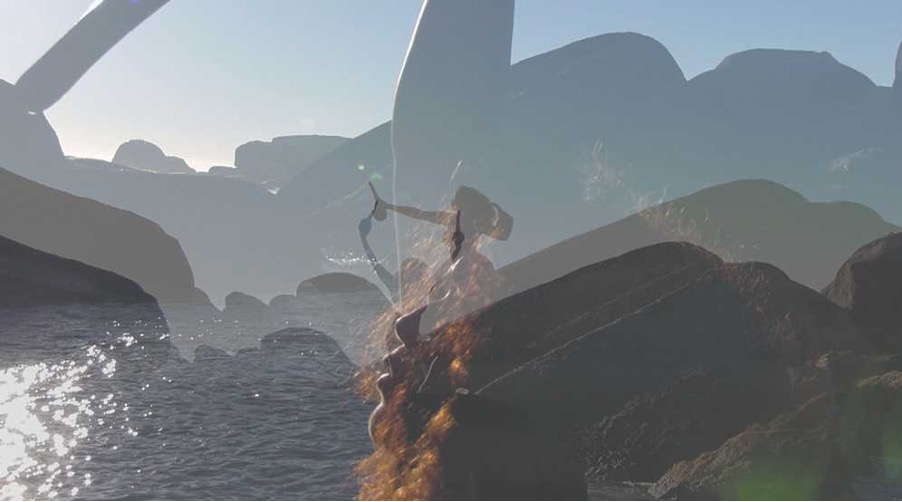
The work of Glaswegian Lucy McKenzie combines traditional oil painting with a variety of other disciplines, including, collaborations in fashion and furniture design, curation, writing, and publishing.
Her recent exhibition at Tate Liverpool is introduced here. It explores the intersection of fine and applied arts, representation and labour, in a series of paintings and objects. It is extremely varied in its style and media because, as she says “As soon as I get the feeling that people pretty much agree on what my work is about, I have the reflexive desire to prove them wrong”
The exhibition highlights themes that have interested the artist throughout her career such as the iconography of international sport, the representation of women, gender politics, music subcultures and post-war muralism.
A skilful painter, McKenzie is known for her use of the trompe l’oeil (trick the eye) technique; paintings that are so convincingly real they literally deceive the eye. Take a closer look at Quodlibet XIII (Janette Murray) 2010 and you’ll discover the pin board, with attached map, knitting pattern, and wool is in fact, a painting.
McKenzie regularly collaborates with other creative artists to make a broader body of work. For example she founded fashion label Atelier E.B. (Edinburgh and Brussels) with Scottish designer Beca Lipscombe. Their work Street Vitrine III Constellation questions some people’s perception of ‘window dressing’ as a talent that requires little skill.
If you are interested in MacKenzie’s work, then please also take a look at the work of Cathy Wilkes and of Victoria Morton, who were major influences on her.

Having a Guyanese father, English mother and born in Scotland, Hew Locke has a broad perspective on colonialism, Empire and migration. His recent work, Procession, currently on display in Tate Britain’s Duveen galleries, is a fantastical pageant of weird and wonderful characters cleverly constructed out of all manner of cheap, mass-produced and globally-sourced stuff – like fake gold, plastic plants and trade beads.
Click here to watch a short video and read more about Locke’s Tate Britain work.
Tate Liverpool also recently showed this 2019 work, Armada, comprising 45 suspended votive boats, each one unique.
His long interest in boats derives from various places; the central part played by them during Empire, his time spent crossing rivers on them in Guyana and his art training at Falmouth in Cornwall.
Locke makes extensive use of cardboard boxes in his work. They represent a whole system of goods migrating constantly around the world carrying all the things we use in our everyday lives. Part boat, part package, part city, part animal, part infestation, Hemmed In Two, demonstrates the beauty of failure. It is made out of a material that is very useful, an everyday material, a perishable material. It is a reflection on the global commodification of culture and its history. It is re-made to fit tightly into whatever space it is shown in.
Interested in Hew Locke? Check out Joy Gregory and Jack Whitten. And there’s Lonnie Holley too, who recently showed at Edel Assanti gallery in London.

The work of Barbadian-born, Glasgow-based artist Alberta Whittle spans continents as her participation in the recent Tate Britain show Life Between Islands: Caribbean-British Art, 50s – Now testified. Having worked in Britain for over 20 years now Whittle’s practice encompasses sculpture and video as well as digital collages. There’s a link here to the exhibition guide, where you can read more about her place within Caribbean-British art.
Whittle’s video, You Can Never Touch the Same Water Twice, from which the still shown here is taken, deals with the importance to her of history and nostalgia along with the frustration of being unable to recover the past. She finds collage, both of moving images, as here, and still images to be the best medium for exploring this problem. She breaks images apart only to overlay and reassemble them to create something new or adjacent to its original meaning.
In the Caribbean, many creative practices often follow a deep reflection of where we all fit within the world today, what we choose to take with us from the past and how we can re-articulate our understanding to create new knowledge.
The ocean and all it represents is central to her art. It is both a graveyard full of ghosts, and a place of deep mystery symbolic of arrival and departure. A highway between worlds, both in the past and now – for good and ill.
You may also be interested in the work of Peter Doig, the Scottish painter who has had the reverse trajectory to Alberta Whittle; born in Scotland but now resident in Trinidad for twenty years. He discusses his life and work here.
Finally, how about enjoying a stroll through the long painting career of British Guiana-born, London-based, Frank Bowling.